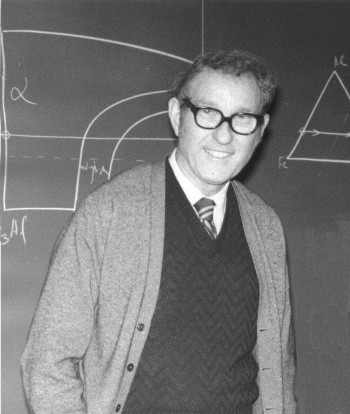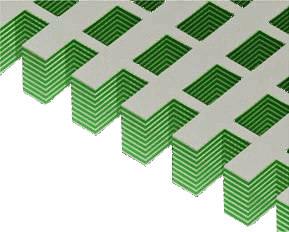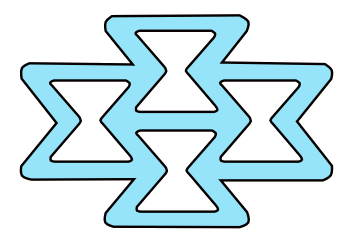Mystifying Metamaterials
May 31, 2012
Every
student has faced this problem. Just when they think they understand something, the
teacher piles on something new. You've just mastered
subtraction, and now you need to learn how to subtract
negative numbers.
Materials scientists have a rich panoply of
materials they try to understand, and now
metamaterials have been thrust upon us. It makes you want to
sell real estate, instead.[1]
Actually, we should be joyful. Once a
climber reaches the top of
Everest, what's he to do? Try it again, climbing backwards; or, climbing on one foot? As long as new materials are found, there will always be a need for scientists to understand them. As I once told my
post-doctoral mentor,
Ed Wallace, if materials were easy to understand, they wouldn't pay us so much money to research them.

William E. (Ed) Wallace, American chemist, 1917–2004.[2]
Although schooled as a chemist, Ed Wallace functioned as a materials scientist whose research involved the fields of chemistry, physics, and metallurgy.
Wallace's specialty was the rare earth elements.
(Wikipedia image by author))
Metamaterials are materials that offer unique properties based on their
geometrical structure, rather than their
specific composition. They are more important today because of our ability to shape material on the
nanoscale. As an example, the layered structure pictured below was formed from alternating layers of
silver and
magnesium fluoride into which were etched nanoscale windows.
Whereas natural materials will exhibit a positive
refractive index, this "fishnet" metamaterial has a negative refractive index for
wavelengths as short as 1500
nm. Nanoscale fabrication is important in this case, since the dimensions of this material need to be smaller than the wavelength of light for the negative refraction to occur.

This University of California, Berkeley, "fishnet" metamaterial presents an array of current loops to an incoming electromagnetic wave. The resultant magnetic field of these currents acts in opposition to the magnetic field component of the light.[3]
(NSF image by Jason Valentine, via Wikimedia Commons))
Most of the recent interest on metamaterials has been because of such unusual optical properties. The ability to produce both positive and negative refractive indices in a material allows creation of
superlenses with resolution beyond the
diffraction limit.
I've often remarked how science seems to pace a few decades behind science fiction. There are numerous examples, such as those from the
Jules Verne novels. The
Klingon cloaking technology on
Star Trek seemed fanciful just a few decades ago, but there has been progress in making
metamaterial cloaking devices. The idea behind cloaking is simple. You just need to bend light around an object such that the background becomes the foreground.
Taking a back seat to all this optical buzz are some unique
mechanical properties of some metamaterials. I wrote about
auxetic materials in a
previous article (Auxetics, May 13, 2011). Auxetic materials exhibit a negative
Poisson's ratio. Poisson's ratio is a mechanical constant of materials that's usually symbolized by the
Greek letter,
ν. It's the measure of how much the material will shrink in a plane when you pull on it. It's essentially the
ratio of the contraction in the x- or y-direction to the extension in the z-direction. Since materials normally get thinner as we pull on them, a negative sign added to make the ratio positive.
Poisson's ratio is usually about 0.3 for most
metals.
Cork's Poisson's ratio is about zero, which makes it ideal for a
bottle stopper application. Cork doesn't expand when pushed into the bottle neck, so it doesn't jam.
Rubber has far different mechanical properties, since its Poisson's ratio is about 0.5.
Auxetic materials were first described in a 1987 paper published in
Science.[3] Auxetics are a prime example of how structure trumps composition as a material property. Auxetics are actually more like
simple machines than materials,
per se, since, on a local level, they operate according to the model shown in the figure.

Model of an auxetic material. Pulling on the right and left edges will make the material grow in the up-down direction.
(Rendered by the author using Inkscape)
As can be seen from the model, auxetic materials need some empty space to function, so they are necessarily low
density materials, and they're not useful in all applications. You can see that auxetic materials have good
impact resistance. When a normal material is
indented, it spreads away from the indenter, but auxetic materials have the opposite response, moving towards the indent to block it.
Two
physicists from
Northwestern University (Evanston, Illinois) have just published a paper in
Nature Materials on materials with another unusual mechanical property, somewhat similar to the negative Poisson's ratio.[5-6] If you push on these materials they'll grow longer in the push direction; and if you pull on them, they will grow shorter in the pulled direction. This behavior, of course, is opposite to what happen in other materials.

Poke it with a stick. Negative compressibility materials become shorter when pulled, and lengthen when pushed. In each case, force F' is larger than force F. (Rendered by the author using Inkscape)
Such negative
compressibility was never thought to be possible, since such materials would be fundamentally unstable if the changes happened in a
continuous fashion.[5] The Northwestern team found that such changes can happen discontinuously, as a type of
phase transition.[5] Says
Adilson E. Motter, the Harold H. and Virginia Anderson Professor of Physics and Astronomy at Northwestern, and lead author of the study,
"This research shows that new materials, in fact, can be created to exhibit a phase transition during which the material undergoes contraction when tensioned or expansion when pressured... We refer to such transformations as 'negative compressibility transitions.'"[5]
Zachary G. Nicolaou, who was an undergraduate student at the time of the study, but is now a graduate student at
Caltech, and Motter looked at materials as
networks of interacting particles, similar to what can be seen in the auxetic material model, in their design of the materials that exhibit such negative compressibility transitions.[5]
Network effects are sometimes counterintuitive, and these include an increase in
electrical current when an internal
conductor is removed; or, how adding another
highway will increase, rather than decrease, travel time.[5] This latter effect, known as
Braess's paradox, was discovered about half a decade ago by the
German mathematician, Dietrich Braess.
A complementary effect, when approached from a
strain, rather than a
stress, perspective, is
force amplification. In this case, a small change in deformation will lead to a large increase in response force.[5-6] This property can be for
actuators, and for
microelectromechanical systems.
This research was supported by the
Northwestern University Materials Research Science and Engineering Center and the
National Science Foundation.[5]
References:
- One of my graduate school colleagues started a camera store after getting his Ph.D.. Another of my colleagues, an expert in electron analytical techniques, now sells real estate.
- OBITUARY: William E. (Ed) Wallace, University Times (University of Pittsburgh), vol. 37, no. 6 (November 11, 2004).
- Roderic Lakes, "Foam structures with a negative Poisson's ratio", Science, vol. 235, no. 4792 (February 27, 1987), pp. 1038-1040.
- Jason Valentine, Shuang Zhang, Thomas Zentgraf, Erick Ulin-Avila, Dentcho A. Genov, Guy Bartal and Xiang Zhang, "Three-dimensional optical metamaterial with a negative refractive index," Nature, vol. 455, no. 7211 (September 18, 2008), pp. 376-379.
- Megan Fellman, "Mystifying Materials," Northwestern University Press Release, May 23, 2012.
- Zachary G. Nicolaou and Adilson E. Motter, "Mechanical metamaterials with negative compressibility transitions," Nature Materials, Advanced Online Publication, May 20, 2012, DOI:10.1038/nmat3331
Permanent Link to this article
Linked Keywords: Student; teacher; subtraction; negative number; materials scientist; material; metamaterial; real estate broker; climbing; climber; Mount Everest; Everest; postdoctoral research; post-doc; mentor; William E. Wallace; Ed Wallace; chemist; chemistry; physics; metallurgy; rare earth element; Wikipedia; physical structure; geometrical structure; chemical compound; composition; nanoscopic scale; nanoscale; silver; magnesium fluoride; refractive index; wavelength; nanometer; nm; University of California, Berkeley; current loop; electromagnetic radiation; electromagnetic wave; magnetic field; Jason Valentine; Wikimedia Commons; superlens; diffraction limit; Jules Verne; Klingon; cloaking device; cloaking technology; Star Trek; metamaterial cloaking device; mechanics; mechanical properties; auxetic material; Poisson's ratio; Greek alphabet; Greek letter; ratio; metal; cork; bottle stopper; rubber; Science; simple machine; Inkscape; density; impact resistance; indentation hardness; indent; physicist; Northwestern University (Evanston, Illinois); Nature Materials; compressibility; continuous function; continuous; phase transition; Adilson E. Motter; Zachary G. Nicolaou; California Institute of Technology; Caltech; network theory; network; electrical current; conductor; highway; Braess's paradox; German; mathematician; strain; stress; force; actuator; microelectromechanical system; Northwestern University Materials Research Science and Engineering Center; National Science Foundation; University of Pittsburgh.